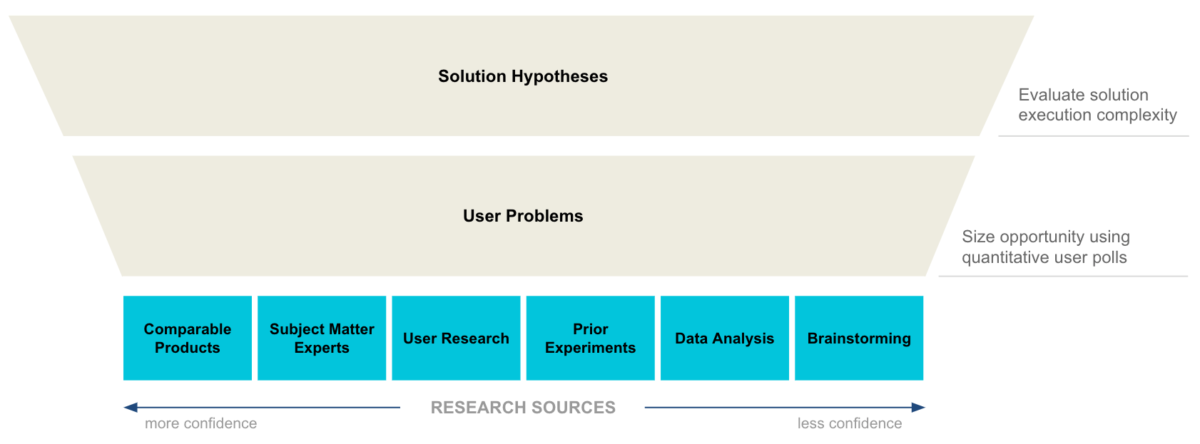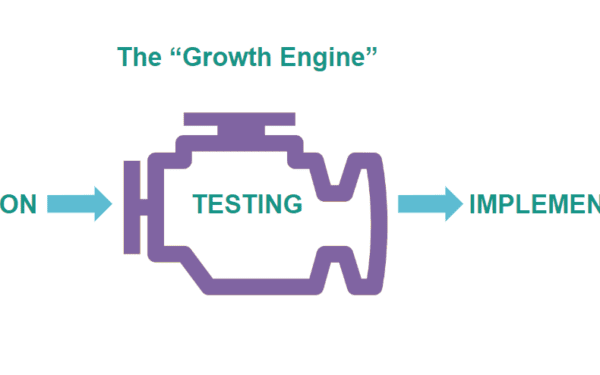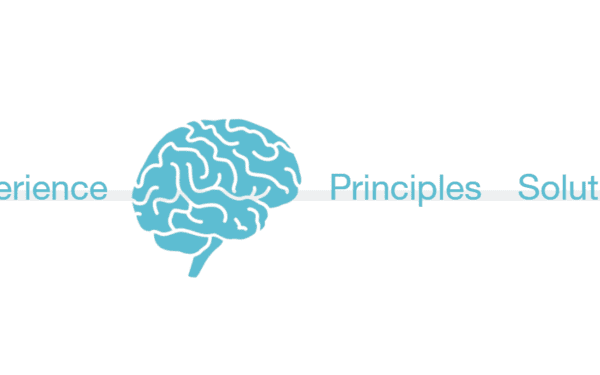3 keys to ideation success
Many people tend to believe that a key responsibility of Product Managers is to come up with ideas. This is true in that you are responsible for having a big, high-quality idea backlog, however, the highest-quality ideation doesn’t come from Product Managers. In fact, I try not to come up with any ideas myself if I can help it.
Let’s start with the fundamentals. There are a few can’t-miss aspects of ideation, which, if you just do these alone, will ensure a great idea/hypothesis backlog.
They are:
- Base your ideation topics around user research.
- Source from multiple, high-confidence idea sources.
- Ensure a high idea quantity (20+).
Let’s break these each down, as well as go into some more advanced techniques.
Setting up foundational user research for roadmap ideation
One of my favorite questions to ask in user research is:
“What are your remaining hesitations or questions with doing [X activity we want you to do]?”
It’s simple, and helps you get right to the point of understanding and ideating around topics that are central to achieving your goal with users.
Here’s an example of a survey we ran on the MasterClass website:

This type of question identifies topics on a “user problems” level. User research at this level helps you directionally start thinking about the blockers of the goal outcome for people. I actually use this feedback to prioritize our quarterly roadmap and projects, along with which hesitations we won’t be addressing.
The next stage of an idea-oriented user survey
The next stage of sophistication with this type of survey is to ask a follow-on question depending on which response they chose. For instance, if they chose “I would only take 1 or 2 of the classes”, we would then follow up with a question like “What best describes your interest in our classes?”, along with an additional set of options they can choose. These responses are at the “user solutions” level.
The great thing about going to the user solutions level is that your work is kind of done for you. I said earlier that I try not to come up with ideas myself, and it’s true. I would rather that our beautiful users do that work for me and make our life easier. Now even at this level, there are still many ways to approach a solution, and ideas you can generate that can be turned into experiments, but there’s much less guessing involved.
It can take multiple years of doing this type of research and running experiments until you have a thorough understanding of these hesitation reasons for people and what it takes to overcome them.
Advanced user research practices
Validating user problem addressability and complexity
This refers to the fact that although 60% of people say that X is an issue, you may only be able to solve the issue for a half of that population of users and the other half is not even in your market. Complexity is related to the difficulty, risk, and effort it would take to solve that issue for users. Some problems are more complex and nuanced to solve than others. The most basic way to go about this validation, is to just ideate around these problems, test a lot, and make sure you are reflecting and learning along the way (tied back to the problems).
Journey mapping
This is a map of all questions, considerations, and feelings someone goes through in their journey towards your goal outcome for them. It’s good to map these questions and considerations to different stages of the journey for a better understanding and stronger hypothesis generation. You generally get this type of info by doing a good amount of qualitative user research, either in-person, or via tools like UserTesting.com. Another source of info can be Google Analytics or Amplitude “top user paths” reports.
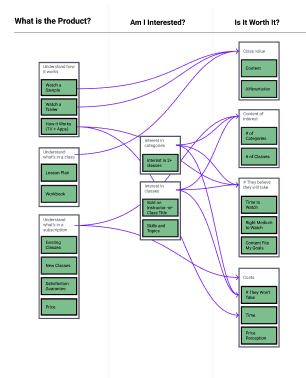
Creating a conversion equation
This can be any goal that you want a user to “convert to”. A conversion equation is a natural follow-on tactic to user journey mapping, in which you look across all of the journey map and identify “in order for a user to get to the goal behavior, these value-driving factors A, B and C, must be perceived to be greater than the costs X, Y and Z for the user”.
For example, when someone is deciding whether to refer another person to the platform, they are evaluating the referral bonus incentive against the costs of time and reputation implications of referring the platform in many cases. For product engagement goals, they are often evaluating the value props they get from using the product against the time it takes to get that value, and alternatives they could be doing with that time. What is the breakdown of your goal’s conversion equation?
High-confidence idea sources
When most people generate ideas for a backlog, what they default to is coming up with ideas themselves or doing a group brainstorm. These are valid tactics, but I would say that they are lower-confidence idea sources because in many cases the ideas aren’t supported by a form of data, are inconsistent, and subject to bias.
Now don’t get me wrong, I definitely so personal and group brainstorming, but it’s important to be factoring in at least 1 or ideally 2-3 other sources in order to develop a high-quality backlog. Two of my favorites are direct user research like discussed in the first section, and comparables research, which is essentially going through 5-10 comparable products and taking ideas from what they are doing that you think could apply to your goals.
Primary idea sources
Here are the main idea sources that I think about. I would say that the “confidence level” of the idea sources goes from highest at the top to lowest at the bottom.
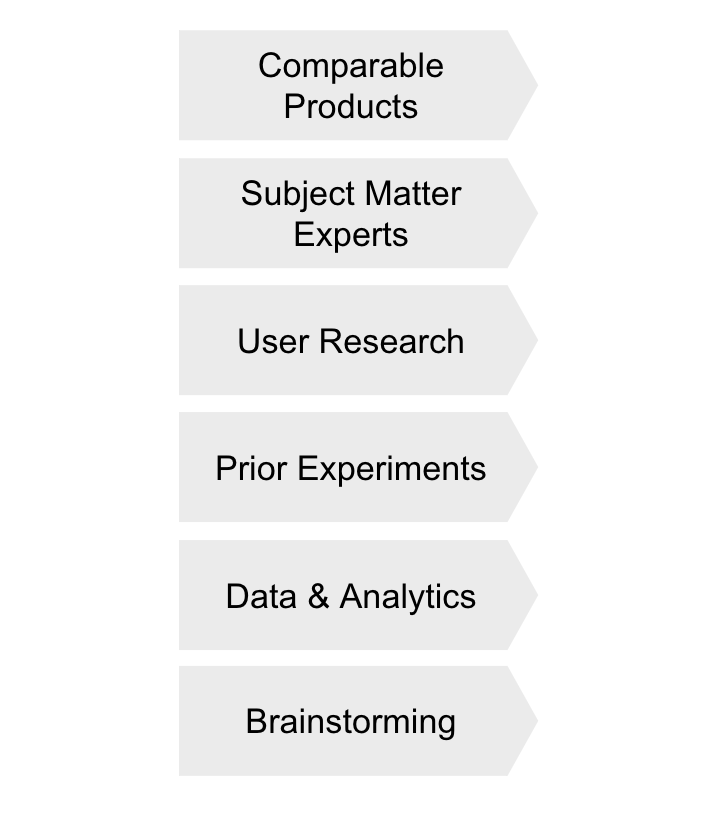
There is a blog post I could write about how to take advantage of each of these idea sources, but for now, what’s important is just making sure that you are using at least 2 in your process. I would say that comparables research is the easiest high-confidence source to start out with in terms of bang for your buck, but you have to make sure that you are researching “established” products rather than up-and-coming products to ensure that the product approaches have been well proven.
What goes into an idea being “high-confidence”
A high level concept you can apply to any idea source is the idea of a balance between how proven something is or how much data there is behind it, and how relevant it is in the context of your product. A tactic can be very proven at an established company, but the slight differences in product or audience can make that tactic not applicable for your goals. Likewise, if the tactic that you are looking at has direct ties and comparison to your product, but is not very proven, then it is difficult to have confidence in it as well.
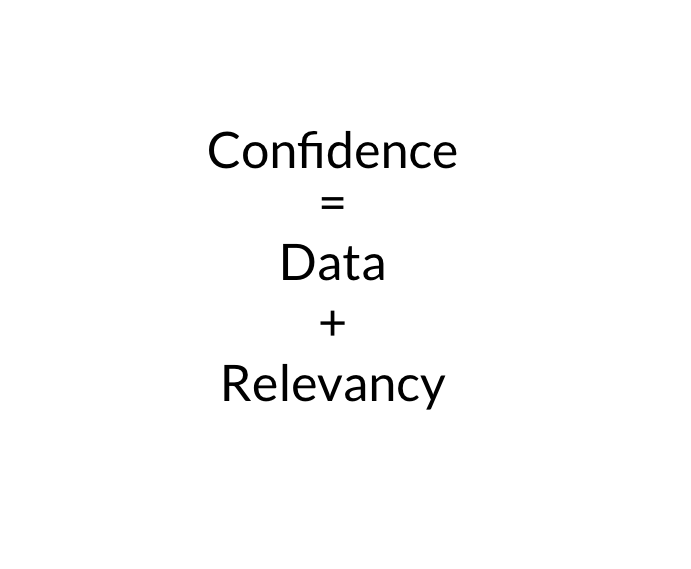
The key though, and the main thing to take-away is just to be thinking of these different elements when evaluating ideas, since it’s very easy to make assumptions that cost you valuable resource time.
Idea quantity
There are a few ways to tackle idea quantity, starting with having enough research to go off of, since a lot of ideas can come right from looking through qualitative and quantitative research.
Your ideation from can be even more fruitful though by practicing these three approaches:
Set research quantity goals.
It’s that simple. For instance, when I do comparables research of different companies I like to shoot for 10 products to go through, and try to have them be diversified by different goals like some from a particular type of product and others that just have good UX but in a different category. This is naturally going to support a lot of idea generation. The other benefit is that you start to notice trends and similarities between comparables at that scale of research.
Refrain from setting high “idea standards”.
I see it all the time, when people frame a brainstorm around “hypotheses”, you’ve unknowingly set a high standard for the brainstorm. For something to be a hypothesis you have to have a thought-through perspective all the way to solution state. You’ve shut out the possibility for more upstream broad and open-ended brainstorming outputs like just ideas, and user questions. It goes questions -> ideas -> hypotheses in terms of ideation maturity.
Set per-person idea goals.
If you’re doing a group brainstorm, you want to set an amount of time for the group to come up with ideas, and as a part of that, you need to set a goal to hit for each person. For example, you start the brainstorm and say “for the next 10 minutes let’s try to come up with a bunch of ideas around this topic – what’s a good number to shoot for, shall we say 10 per person?”. There’s some psychological studies behind this which you can find online I’m sure, but the fact is that you will get at least 2 times as many idea from people with this tactic.
More sophisticated product teams build these elements into their core processes so that they are always coming up with high quality ideas. You do this by continually doing and sharing user research, noting down ideas and questions from the group outside of dedicated brainstorm sessions, and building an expectation and culture around bringing ideas to the table on an ongoing basis. John Egan, Head of Growth Engineering at Pinterest, talks about this dynamic in hist post on “How to Supercharge Your Growth Engineering Team With Experiment Idea Review“
Summary
Having a strong ideation process may be the most important aspect of a good product development program. Why? Because it is the tip of the spear, it is the top of your product development funnel. Without good ideation, you will have lower-quality features and experiments which will ultimately hurt your ability to meet and surpass your metrics goals. By grounding your ideation in a base of user research, leveraging high-confidence idea sources, and leaning on idea quantity, you set yourself up for maximum levels of impact on the business.
